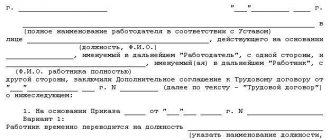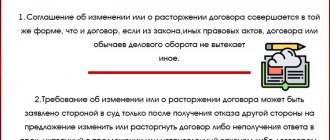The legislative framework
Let us turn to the Federal Tax Service Letter No. SD-4-3/ [email protected] dated 10.23.2018. It provides clarification on how to deal with this tax during the transition period. From January 1, everyone without exception switched to 20%. And it doesn’t matter when the contract was concluded.
But usually the document strictly states “18 percent.” This means that this condition needs to be officially adjusted. Accordingly, if tax conditions are not specified in the text, then there is no need to sign anything additional.
Some prescribed in advance the possibility of revising the cost unilaterally when amending the legislation. They also don’t need extra documents.
Is it necessary to draw up an additional agreement to the contracts?
The additional agreement on changing the value added tax rate should resolve all discrepancies that arose in connection with amendments to the legislation. In general, its structure looks like this:
- A title indicating the number and date of conclusion of the original document.
- Date and city of signing.
- Point to be reformulated.
- Its new edition.
- Effective date of the new provisions.
- Details and signatures.
We discussed above how to correctly specify the VAT rate in the contract. However, in the additional agreement it is advisable to do this as precisely as possible.
But there is another opinion. In accordance with it, during the transition period it is better to refrain from indicating the amount of tax liability. This applies to both percentage and monetary terms. It is better to simply refer to paragraph 3 of Article 164 of the Tax Code.
More about VAT
- recommendations and assistance in resolving issues
- regulations
- forms and examples of filling them out
ConsultantPlus TRY FREE
On January 1, a new rate of 20% came into effect. If the goods are shipped after this date, the new rate will need to be used in the documents, even if the supply contract was concluded in the previous year.
https://www.youtube.com/watch?v=ytadvertiseru
In order to avoid incurring losses due to claims from counterparties and disputes with the tax inspectorate, it is necessary to immediately audit the concluded supply agreements and make adjustments to them. This is usually done by concluding an additional agreement.
We invite you to find out how sick leave for child care is paid
The following agreements need to be corrected:
- If the contract directly states that a rate of 18% is used, the additional agreement must indicate the cost of the goods without VAT and indicate that VAT is charged on top of this price at the rate in effect at the time of shipment;
- If the contract indicates only the cost of the goods without VAT, in such a situation it is not necessary to change the contract, but it is better to indicate in the additional agreement that VAT is charged on top of the price at the current rate. Thanks to this, it will be possible to definitely avoid disputes with buyers;
- The contract does not mention VAT at all - the additional agreement provides information that the contract price does not include VAT, and the tax is charged on top at the current rate.
There is no need to make changes to the following agreements:
- If the cost of goods or services is determined not in the contract itself, but in the documents attached to it (estimates, specifications, etc.);
- If the company sells work or goods that are subject to a 0% or 10% rate;
- If the contract contains a clause stating that the seller has the right to unilaterally increase the cost of goods or services when the amount of tax increases.
There will be no exception to the situation in which the buyer refuses to sign an additional agreement to increase the cost of the goods. In this case, the difference in price will be borne by the supplier company in the form of a reduction in the selling price.
The seller, of course, can sue and force him to sign an additional agreement based on a court decision. However, this judicial practice is just beginning to take shape, and therefore it is impossible to predict exactly what position the court will take.
Attention! It is worth noting that the tax inspectorate in its letter dated October 23, 2018 No. SD-4-3/ [email protected] indicates that it is not mandatory to enter into additional agreements. In any case, from January 1, 2020, a rate of 20% will apply, regardless of what is specified in the supply agreement.
How to specify a change in the VAT rate in a contract
It all depends on what formulations were used initially. The following options are possible (for example, let’s take the cost of 100,000 rubles).
100,000 rub. + VAT
There is no need to change anything, since the exact amount of the tax is not given
100,000 rub. excluding VAT
There is no need to change anything, since there is no indication of the amount of tax
100,000 rubles + 18%
Change to current value
100,000 rubles + 20%
118,000 rubles, including value added tax 18,000 rubles
Recalculate taking into account the current value
120,000 rubles, including value added tax 20,000 rubles
A letter sent to a counterparty about a change in the VAT rate is an example of the fact that you are trying to prevent all possible omissions in advance.
Is it mandatory or not to indicate VAT in the contract?
A frequent cause of dispute between counterparties is the question of whether it is necessary to indicate the VAT rate in the contract. According to some reports, the amount of tax that is presented to the buyer when selling products should be taken into account when calculating the final price. The answer to the question whether it is necessary to highlight it in the accounting documents in the contract is affirmative.
Most forms of primary documents have special fields for highlighting tax. However, there are some documents that do not have a unified form, for example, an agreement. The allocation of tax may not be mandatory when selling goods to organizations that apply a special regime, or if services or products are exempt from taxation upon sale.
Do I need to make changes to the contract?
Let us immediately make a reservation that, regardless of whether or not a VAT rate of 20% is indicated in the contract with the buyer instead of a rate of 18%, the sale of goods, works, and services that takes place after 01/01/2019 must be taxed at an increased VAT rate. Accordingly, the only question is at whose expense the 2% difference in VAT will be covered.
It’s one thing if the cost of goods (work, services) in the contract is indicated, for example, like this: “5,900 rubles + VAT” or “5,900 rubles excluding VAT.” Then in 2020 the seller will simply have to charge VAT in the amount of 1,180 rubles (5,900 * 20%), and the buyer will no longer have to pay 6,962 rubles (5,900 + 5,900 * 18%), but 7,080 rubles (5,900 + 1,180) or (if an advance payment was already made in 2020) – pay the difference. There will be no need to make any changes to the contract.
But it is more likely that the cost in the contract was indicated, for example, like this: “5,900 rubles, incl. VAT 900 rubles” or “5,900 rubles, incl. VAT 18%.” In this case, it is advisable for the parties to draw up an additional agreement to the contract, stipulating how the total cost of goods (work, services) will be determined and how VAT will be calculated - “including” or “in addition.”
In an additional agreement, for example, the following wording can be given:
“Clause 4.1 of the Agreement shall be stated as follows: “The price of a unit of goods under the Agreement is 5,900 rubles, incl. VAT 20%"
Please note that the seller has no right to unilaterally increase the price of goods without the buyer’s consent. Suppose the price was set at 5,900 rubles, incl. VAT 18% in the amount of 900 rubles. Due to the VAT increase, the seller calculated that the cost of the goods is now 6,000 rubles, incl. VAT. It would seem that since VAT is an indirect tax and is paid at the expense of the buyer, the increase in cost from 5,900 rubles to 6,000 rubles is natural. After all, only in this case will the seller have a net value without VAT in the amount of 5,000 rubles ((5,900 – 900) = (6,000 – 1,000)). But, on the other hand, VAT is an integral part of the price and it is impossible to demand VAT from the buyer in excess of the value agreed upon by the parties (Resolution of the Presidium of the Supreme Arbitration Court dated September 22, 2009 No. 5451/09 in case No. A50-6981/2008-G-10, Ruling of the Supreme Arbitration Court dated November 23, 2009 .2017 No. 308-ES17-9467 in case No. A32-4803/2015).
That is why, in order to avoid possible claims of the parties, making changes to the contract in order to clarify the cost and amount of VAT is advisable.
When the buyer prepays goods in 2020, the cost of which is calculated taking into account the VAT rate of 20%, or when additionally paying 2% VAT in 2019 to the advance payment transferred before 01/01/2019, it is necessary to take into account the transitional provisions that we discussed here.
When concluding ongoing contracts during the transition period, i.e. when they are concluded in 2020, but executed after 01/01/2019, in order to avoid the need for subsequent changes, it may be recommended not to indicate a specific VAT rate, but to state the condition that :
- or the cost of goods (work, services) is established without VAT, and VAT is calculated additionally at the rate provided for in clause 3 of Art. 164 Tax Code of the Russian Federation;
- or the cost of goods (work, services) includes VAT at the rate provided for in clause 3 of Art. 164 Tax Code of the Russian Federation.
From the beginning of 2020, an increased VAT rate came into effect. Now it is 20%. In this regard, entrepreneurs had to prepare for changes. A company may have an agreement that was concluded before the new year, but continued to be valid after the onset of 2020. It is assumed that prices are indicated taking into account the previous VAT of 18%. Is it necessary to draw up an additional agreement in this case? It all depends on the specific case.
What do officials say about changes in the contract price when the VAT rate increases?
Law No. 303-FZ dated 03.08.18 amends the VAT rate specified in clause 3 of Art.
164 Tax Code of the Russian Federation. From January 1, 2020, the tax rate will increase from 18 to 20%. The increase in VAT will not affect all taxpayers: there is a preferential list of goods, their sellers will remain working at a rate of 10%.
https://www.youtube.com/watch?v=ytpolicyandsafetyru
Sellers of “preferential” types of goods using a 10% rate. This applies to goods and services listed in paragraph 2 of Art. 164 Tax Code of the Russian Federation:
- food, except delicacies;
- children's clothing and footwear, except sportswear;
- books and periodicals, except advertising and erotic publications;
- medical products;
- domestic air transportation services.
Exporters and other businessmen using the 0% rate. The list is given in paragraph 1 of Art. 164 Tax Code of the Russian Federation:
- international shipping;
- supply of foreign diplomatic missions in the Russian Federation;
- transportation of gas, oil and petroleum products;
- customs processing;
- international electricity supplies.
Taxpayers under the general tax regime who operate in the domestic market and sell goods not included in the preferential list. For them, the rate will increase by 2 percent - from 18% to 20%.
The settlement rate applied in special cases will increase from 15.25% to 16.67%:
- Sale of an entire enterprise as a property complex (clause 4 of article 158 of the Tax Code of the Russian Federation);
- Provision by non-resident organizations of electronic services for individuals residents of the Russian Federation (clause 5 of Article 174.2 of the Tax Code of the Russian Federation):
- advertising placement;
- services of electronic trading platforms;
- provision of domain names, hosting services, website administration and support;
- searching, storing and processing information via the Internet;
- granting rights to use books, audiovisual works and other information presented in electronic form.
| Natalya Tantsyura, head of the Dispute Resolution practice, United Consulting Group, explains how the rate increase will affect business: |
Government agencies provide clarifications that are unlikely to please sellers.
The Ministry of Finance, in information letter No. 24-03-07/61247 dated August 28, 2018, indicated that an increase in the VAT rate should not lead to a change in the price of government contracts. Therefore, sellers working under government contracts will, in most cases, have to compensate for the increase in the VAT rate at their own expense. An exception is large transactions, the volumes of which exceed the limits established by Decree of the Government of the Russian Federation dated December 19, 2013 No. 1186:
- 10 billion rubles for federal needs;
- 1 billion rubles for the needs of constituent entities of the Russian Federation;
- 500 million rubles for municipal needs.
For all other categories of contracts, the Federal Tax Service of the Russian Federation, in its letter dated October 23, 2018 No. SD-4-3 / [email protected] , comes to a similar conclusion. According to officials, there is no connection between the increase in the VAT rate and the need to amend the agreement.
However, in the same letter, Federal Tax Service specialists indicate that the parties retain the right to change the terms by agreement. If it is not possible to reach an agreement, all that remains is to rely on the court.
When to enter into an additional agreement
Example. in 2020 entered into an agreement with for the supply of building materials. made an advance payment in 2020, but she received the parts only in 2020. If an additional agreement is not concluded, one of the companies will suffer losses due to an increase in VAT.
You can record an increase in VAT in the following ways:
- Price adjustment taking into account the changed VAT rate. You can specify from what date the new cost will be applied.
- Indication of the cost without indicating the exact VAT rate, with reference to paragraph 3 of Article 164 of the Tax Code.
- Fixation of cost taking into account the new VAT, taking into account paragraph 3 of Article 164 of the Tax Code.
It is recommended to make a reference to Article 164 of the Tax Code, on the basis of which the VAT rate changes.
Who will pay for the rate increase?
Who should pay the extra 2%? Seller or buyer? Depends on the terms of the concluded contract.
If the terms of the contract provide for a price adjustment when VAT increases, the buyer pays the difference of 2%. In this case, he will have to come to terms with the price increase, since the terms of the transaction will not allow this fact to be challenged.
If the price of the product was 1,000 rubles without VAT and 1,180 rubles with VAT, then from 01/01/2019 it will be 1,200 rubles with VAT.
As a result, the buyer will pay 20 rubles more or 1.7% (20 rubles / 1,180 rubles).
If the price in the contract is indicated including VAT and does not provide for adjustment, it can only be changed by agreement of the parties. In this case, the buyer, guided by the principle of freedom of contract (Article 421 of the Civil Code of the Russian Federation), is not obliged to meet the seller halfway and may not agree to an increase in price.
We invite you to familiarize yourself with the Gift Agreement between relatives; is it necessary to fill out a personal income tax declaration?
Then the seller, starting from 01/01/2019, will be required to allocate VAT at a rate of 20% from the total sales price.
If the final price of a product unit is 1,180 rubles, then the price without VAT after 01/01/2019 will be equal to 1,180 rubles / 120 × 100 = 983.33 rubles.
The seller will lose 16.67 rubles. (1,000 rubles - 983.33 rubles) or 1.67% of the cost.
When the buyer pays VAT, the seller may try to negotiate with him, citing the fact that the “additional” 20 rubles can be deducted on the declaration and reduce the amount payable to the budget. As a result, the buyer will lose practically nothing. The difference is that you will have to pay the supplier immediately, and the savings on VAT will arise at the end of the tax period (quarter).
If the buyer works under one of the special tax regimes and does not pay VAT, then he takes the entire amount into account as expenses and loses 1.7% “irrevocably”. In this case, the seller can offer a compromise - split the difference in half. That is, at a price of 1,000 rubles excluding VAT, increase the total amount not by 20, but by 10 rubles - up to 1,190 rubles.
| Olga Anatolyevna Shvedchikova, Deputy General Director for Economics of Market Line LLC, tells how the increase in VAT will affect businesses that pay tax at a rate of 10%. |
What needs to be specified in the additional agreement
An additional agreement to the contract is drawn up in the event of a change in the conditions specified in it or the circumstances in which the parties operate. It is drawn up in the same form as the main agreement, and after signing by the parties it becomes an integral part of it.
In the text of the additional agreement, only the clauses that have undergone adjustment are given with reference to their numbers in the main agreement, after which the text of this clause is stated in the new edition.
In addition, the document states:
- date of signing of the main agreement;
- numbers of the main contract and additional agreement;
- place of signing;
- names of the parties;
- Full name of the persons who signed the additional agreement;
- details of the parties and their signatures.
As a general rule, the additional agreement comes into force on the day of signing, but according to Art. 425 of the Civil Code of the Russian Federation, the parties can change this date.
Sample additional agreement drawn up when VAT is increased to 20%
The form of the document has not been officially approved, so counterparties can develop their own sample additional agreement on increasing VAT, taking into account the provisions formulated in the main agreement.
Example
Since 01/01/2015, Polet LLC has been renting office space from Tsentralny LLC. The rent until December 31, 2018 was 11 thousand 800 rubles, including VAT 18% - 1 thousand 800 rubles.
After changing the VAT rate from January 1, 2019, the rent increased to 12 thousand rubles. including VAT 20% - 2 thousand rubles. The decision made was recorded in the additional agreement.
Additional Agreement No. 3
to lease agreement No. 215/04 dated 01/01/2015
01/10/2019, Moscow
https://www.youtube.com/watch?v=ytaboutru
Polet LLC, hereinafter referred to as the Tenant, represented by director P.N. Rozanov, acting on the basis of the charter, on the one hand, and Centralny LLC, hereinafter referred to as the Lessor, represented by director I.V. Mishina, on the other hand have entered into this additional agreement to the purchase and sale agreement No. 125/wholesale dated May 12, 2015 as follows.
Amend clause 4.3 of the above-mentioned agreement as follows:
- Set the rent amount from 01/01/2019 to 12,000 (twelve thousand) rubles, including 20% VAT.
This agreement is drawn up in two equal copies, one for each of the parties.
The additional agreement comes into force on 01/01/2019.
| ADDRESS | ADDRESS |
| and details of the Lessor | and details of the Tenant |
| Taxpayer Identification Number _______________________ | TIN ____________________ |
| OGRN_______________________ | OGRN ____________________ |
| Address:_____________________ | Address: __________________ |
| Check ______________________ | Check ___________________ |
| Bank: _____________________ | Bank: __________________ |
| BIC ______________________ | BIC ___________________ |
| Correspondent account ______ __________________________ | Correspondent account ____ _________________________ |
| E-mail: ____________________ | E-mail: __________________ |
| Tel. ______________________ | Tel. ____________________ |
| _____________________ Signature of the Lessor's representative | _____________________ Signature of the Tenant's representative |
| M.P. | M.P. |
Contracts with dedicated stages of delivery and acceptance of work are no exception.
In the examples above, we emphasized that the contracts do not provide for phased delivery and acceptance of work. However, this was done only to bring certainty to the conditions of the situation under consideration. For contracts with dedicated stages, the same approach is applied - the tax rate is determined on the date of shipment. In this regard, it is possible that, within the framework of one contract, the implementation of work will be taxed at different rates (18 and 20%).
Example 5.
In accordance with the agreement concluded with the general contractor, the subcontractor performs work at the customer’s site.
Work on the first stage was handed over to the general contractor in November 2020, on the second - in February 2020.
When calculating VAT on the implementation of work, the contractor applies a rate of 18% in 2020, and 20% in 2020.
How not to quarrel with counterparties?
What should you do to minimize the impact of government innovations on the degree of “friendliness” and mutual benefit of your cooperation with counterparties? That's right - transfer all the “arrows” to the current legislation.
For sellers of goods, services, works, etc., it is ideal to stipulate in the contract the amount of VAT in the following formulation: price + VAT at the rate established by current legislation. Without numbers and “boorish” possibilities to change something unilaterally. And, of course, do not forget to remind your buyer that the amount of tax he will claim for deduction will increase (if he uses the general system).
Buyers, of course, are more profitable to insure themselves in advance against such innovations and indicate in the contract that the specified price (which already includes VAT at the current rate) does not depend on fluctuations in the amount of tax.
If your agreement provides for other terms of cooperation, then you cannot do without an additional agreement to the agreement on changing VAT. And many questions in this case arise if the contract does not separately indicate the amount of VAT.
More details
Why an additional agreement?
Regardless of whether you will enter into additional agreements to existing contracts or renew them for some reason, you must first agree on new terms of cooperation with your counterparties. When choosing between these two methods to document a different procedure for calculating VAT, it is more convenient to stop at concluding an additional agreement and discuss a specific clause of the agreement with the counterparty.
Concluding a new agreement may cost you time and nerves, because following an increase in tax, you will have to revise a number of the terms of the document, as well as a number of attached primary documents.
Who is at risk from VAT changes and what?
If the price (with or without VAT) is indicated in the specification, and the contract contains only a link to this document, naturally only the appendix is subject to change. In this case, no additional agreement is required. However, this does not change the essence - you will still have to discuss with your partner how your cooperation will change.
Anticipating Expectations
As soon as it became known about the VAT increase, 1C-WiseAdvice specialists decided to anticipate all customer questions and prevent problems due to the change in rate. We not only made all the necessary settings for accounting, but also prepared detailed instructions for our clients on switching to 20% VAT.
Preparations for the transition to a new rate began in the summer of 2018 - the checklist, laid out in stages, saved our clients from the need to urgently rebuild their work - from contracts to settings in online cash registers.
Has your accounting department taken care of your business as well?
How to calculate VAT during the transition period
Let's consider “transitional” cases of tax payment from the point of view of both parties to the transaction. We are talking about a situation where the advance payment is transferred in one period, and the shipment is made in the next. Let's consider an advance payment, since if payment is received after shipment, its period does not affect the calculation of VAT.
The main criterion for determining the rate is the period of payment of the advance payment or sale (purchase) of the goods.
If the advance applies to the 2020 shipment, then:
- it is more profitable for the buyer to pay an advance in 2020 in order to recoup 2 percentage points more;
- it is more profitable for the seller to receive an advance in 2020 in order to pay 2 percentage points less in tax.
After shipment, both parties to the transaction will have to pay the tax in full, but in the current period you can get a small savings.
In 2020, a buyer may want to return an item purchased in 2020. When the goods have already been accepted for accounting, they can only be returned if they are sold back to the seller with an invoice issued “on a general basis.” Then the situation will be “mirror” compared to that discussed above. If the parties do not agree on a price change, then the buyer “suffers”, who now sells the goods and is forced to charge additional VAT on return shipment.
Increasing the VAT rate and settlements between counterparties
The increase is reflected not only in the documents, but also in the most important thing – the board.
To avoid difficult uncompromising situations, you need to know how to make calculations. To find out a specific amount you need to use formulas. If you know the cost of the product or work taking into account the percentage, then the sample will look like this:
PRICE WITH %/(1+ RATE) * VAT PERCENT
That is, if the goods were shipped before the beginning of 2020, instead of brackets and “VAT percentage” the values 1,180.18 are used.
After the changes are made, starting from January of this year, 1,20,2 will be substituted for the same positions.
From these diagrams it is clear that the number of percent itself increases by 20, but at the same time, the cost of the product decreases. To be accurate, you need to entrust the accounting work to experienced accountants and carefully read the terms and conditions specified in the transition agreement.






